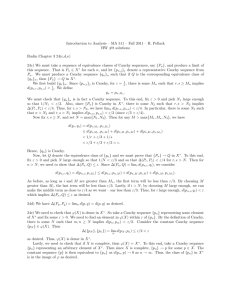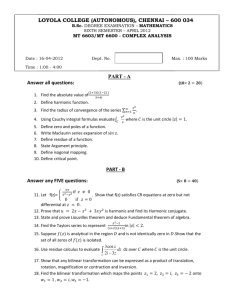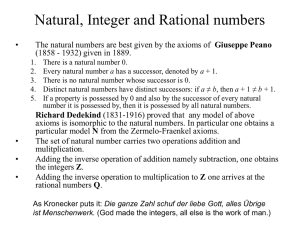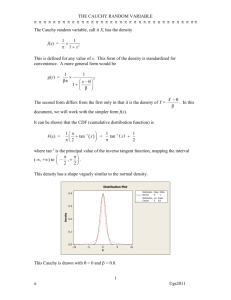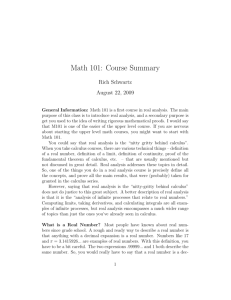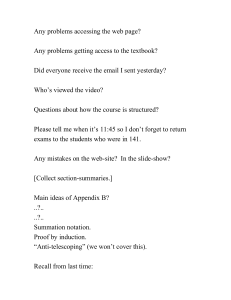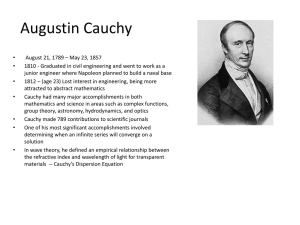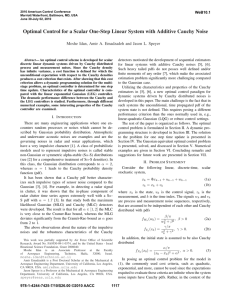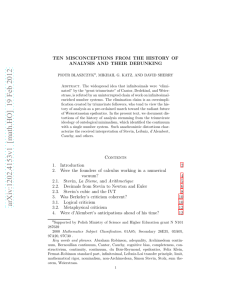Solutions
advertisement
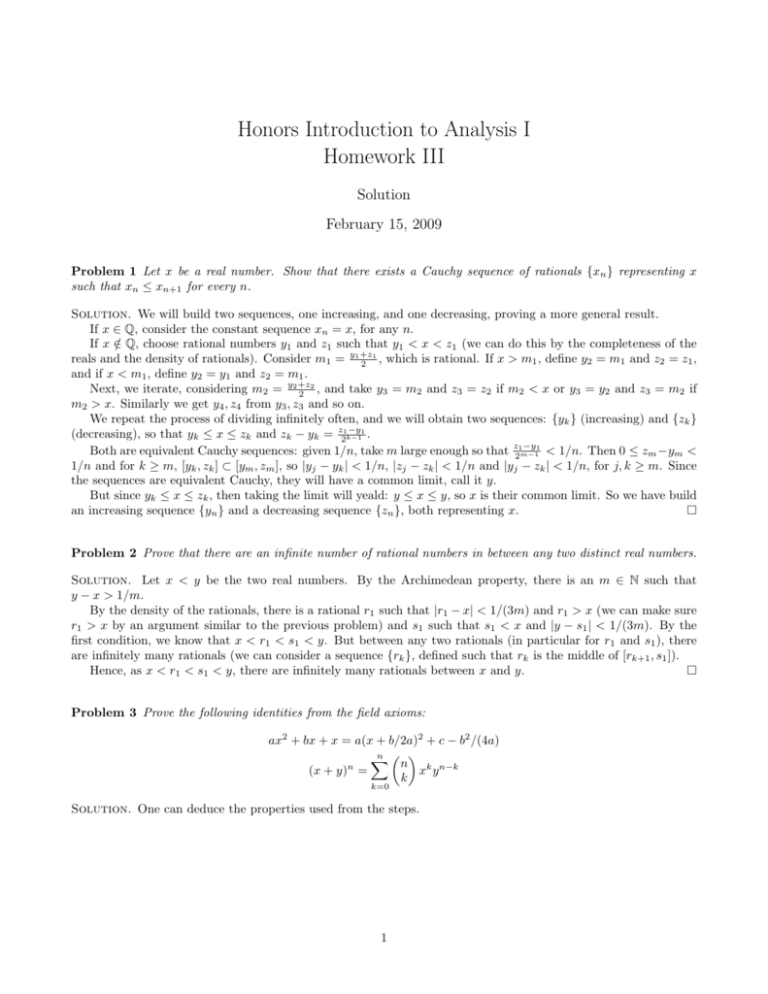
Honors Introduction to Analysis I
Homework III
Solution
February 15, 2009
Problem 1 Let x be a real number. Show that there exists a Cauchy sequence of rationals {xn } representing x
such that xn ≤ xn+1 for every n.
Solution. We will build two sequences, one increasing, and one decreasing, proving a more general result.
If x ∈ Q, consider the constant sequence xn = x, for any n.
If x ∈
/ Q, choose rational numbers y1 and z1 such that y1 < x < z1 (we can do this by the completeness of the
1
reals and the density of rationals). Consider m1 = y1 +z
2 , which is rational. If x > m1 , define y2 = m1 and z2 = z1 ,
and if x < m1 , define y2 = y1 and z2 = m1 .
2
Next, we iterate, considering m2 = y2 +z
2 , and take y3 = m2 and z3 = z2 if m2 < x or y3 = y2 and z3 = m2 if
m2 > x. Similarly we get y4 , z4 from y3 , z3 and so on.
We repeat the process of dividing infinitely often, and we will obtain two sequences: {yk } (increasing) and {zk }
−y1
(decreasing), so that yk ≤ x ≤ zk and zk − yk = z21k−1
.
−y1
Both are equivalent Cauchy sequences: given 1/n, take m large enough so that z21m−1
< 1/n. Then 0 ≤ zm −ym <
1/n and for k ≥ m, [yk , zk ] ⊂ [ym , zm ], so |yj − yk | < 1/n, |zj − zk | < 1/n and |yj − zk | < 1/n, for j, k ≥ m. Since
the sequences are equivalent Cauchy, they will have a common limit, call it y.
But since yk ≤ x ≤ zk , then taking the limit will yeald: y ≤ x ≤ y, so x is their common limit. So we have build
an increasing sequence {yn } and a decreasing sequence {zn }, both representing x.
Problem 2 Prove that there are an infinite number of rational numbers in between any two distinct real numbers.
Solution. Let x < y be the two real numbers. By the Archimedean property, there is an m ∈ N such that
y − x > 1/m.
By the density of the rationals, there is a rational r1 such that |r1 − x| < 1/(3m) and r1 > x (we can make sure
r1 > x by an argument similar to the previous problem) and s1 such that s1 < x and |y − s1 | < 1/(3m). By the
first condition, we know that x < r1 < s1 < y. But between any two rationals (in particular for r1 and s1 ), there
are infinitely many rationals (we can consider a sequence {rk }, defined such that rk is the middle of [rk+1 , s1 ]).
Hence, as x < r1 < s1 < y, there are infinitely many rationals between x and y.
Problem 3 Prove the following identities from the field axioms:
ax2 + bx + x = a(x + b/2a)2 + c − b2 /(4a)
n X
n k n−k
n
(x + y) =
x y
k
k=0
Solution. One can deduce the properties used from the steps.
1
•
2a
b2
b2
bx + c +
−
2a
4a 4a
2
b
b
b2
= ax2 + a2x +
+c−
2a 4a
4a
2
b2
b
b
= ax2 + a2x + a 2 + c −
2a
4a 4a
2
b
b2
b
= a x2 + 2x + 2 + c −
2a 4a
4a
2
2
b
b
=a x+
+c−
2a
4a
ax2 + bx + c = ax2 +
• We will use induction on n ≥ 0. For n = 0, we have (x + y)0 = 1 =
0 0 0
x y = 1 · 1 · 1 = 1.
0
Asssume it is true for n and we prove it for n + 1.
n+1
(x + y)
n X
n
n
= (x + y) (x + y) =
n X
n
k
!
k n−k
x y
(x + y)
k=0
n X
n k n−k+1
x y
k
k
k=0
k=0
n n X
X
n
n k n−k+1
n+1
n+1
k n−k+1
=x
+y
+
x y
+
x y
k−1
k
k=1
k=1
n X
n
n
n+1
n+1
=x
+y
+
+
xk y n−k+1
k−1
k
k=1
n X
n + 1 k n−k+1
x y
= xn+1 + y n+1 +
k
=
xk+1 y n−k +
k=1
=
n+1
X
k=0
n + 1 k n+1−k
x y
k
We have used the identity
n
n
n+1
+
=
.
k−1
k
k
Problem 4 Prove the following identities from the ordered field axioms:
(x2 + y 2 )/x2 ≥ 1, x 6= 0
2xy ≤ x2 + y 2
x/y > x if x > 0 and 0 < y < 1
Solution.
•
(x2 + y 2 )/x2 = x2 · (x2 )−1 + y 2 · (x2 )−1 = 1 + y 2 · (x2 )−1 ≥ 1 + 0 = 1
Since y 2 > 0 and x2 > 0 (hence (x2 )−1 > 0) and multiplication of positive numbers is positive.
• As (x − y)2 ≥ 0 (square of any real is positive), we get: x2 − 2xy + y 2 ≥ 0. By adding on both sides 2xy, we
don’t change the direction of the inequality, so
(x2 − 2xy + y 2 ) + 2xy ≥ 2xy ⇔ x2 + y 2 ≥ 2xy
2
• As 0 < y < 1, then 0 < 1 < y −1 , hence, as multiplication with a postive number x preserves the direction of
the inequality, x · 1 < x · y −1 , so x < xy
Problem 5 Prove that every real number x has a unique real cube root.
Solution.
Existence We apply the “divide and conquer” method. We can just analyze the case when x ≥ 0, since for the
case x ≤ 0, we deal in the same way, with the difference√that the inequalities will go in the opposite direction.
First we find the numbers y1 and z1 such that y = 3 x lies between them. If x > 1 then x3 = x + x(x2 − 1) =
x + x(x − 1)(x + 1) > x since x(x − 1)(x + 1) > 0. From 1 < x < x3 , we expect 1 < y < x, so set y1 = 1 and z1 = x.
(Note that if x < −1, then x3 < x, so we will set y1 = x and z1 = −1). Also if 0 < x < 1, we take y1 = x and
z1 = x (if −1 < x < 0, we switch them: y1 = x and z1 = x). If x = ±1 then take y = ±1.
1
So we have y13 ≤ x ≤ z13 . Now we consider the midpoint m1 = y1 +z
2 . We choose the next interval y2 to z2 to be
3
either [y1 , m1 ] or [m1 , z1 ] in the following way: if m1 > x, take y2 = y1 and z2 = y1 ; if m31 < x, take y2 = m1 and
z2 = z1 ; if m31 = x, then set y = m1 . We will have y23 ≤ x ≤ z 3 .
3
3
2
We iterate, considering m2 = y2 +z
2 , and take y3 = m2 and z3 = z2 if m2 < x or y3 = y2 and z3 = m2 if m2 > x
3
or y = m2 if m2 = x. Similarly we get y4 , z4 from y3 , z3 and so on. √
We repeat the process of dividing infinitely often (unless we hit 3 x), and we will obtain two sequences: {yk }
−y1
(increasing) and {zk } (decreasing), so that yk3 ≤ x ≤ zk3 and zk − yk = z21k−1
.
−y1
< 1/n. Then 0 ≤ zm −ym <
Both are equivalent Cauchy sequences: given 1/n, take m large enough so that z21m−1
1/n and for k ≥ m, [yk , zk ] ⊂ [ym , zm ], so |yj − yk | < 1/n, |zj − zk | < 1/n and |yj − zk | < 1/n, for j, k ≥ m.
Since the sequences are equivalent Cauchy, they will have a common limit, call it y. Since yk3 ≤ x ≤ zk3 , passing
to the limit gives: y 3 ≤ x ≤ y 3 , so y 3 = x, hence x has a cubic root.
Uniqueness Assume there are two distinct cubic roots z 3 = y 3 = x. Then
0 = z 3 − y 3 = (z − y)(z 2 + zy + y 2 ) = (z − y)[(z + y/2)2 + 3/4y 2 ]
But (z + y/2)2 + 3/4y 2 > 0, since if both terms would be 0, then y = z = 0 (contradictinv z, y distinct), hence
z − y = 0, so z = y proving uniqueness.
Problem 6 Let {xn } be a sequence of real numbers such that |xn | ≤ 1/2n , and set yn = x1 + x2 + . . . + xn . Show
that the sequence {yn } converges.
Solution. We will show that {yn } is Cauchy. We observe that, for any j > k:
j
j
j
X
X
X
1
1
1
1
1
|yj − yk | = xn ≤
|xn | ≤
=
1
+
+
.
.
.
+
= k+1
n
k+1
j−k−1
2
2
2
2
2
n=k+1
n=k+1
n=k+1
1
−
2j−k
1
2
1
=
1
1
1
− k ≤ j
j
2
2
2
This means that for any n ∈ N, there is m such that 2m is the closest power of 2 to n (and 2m > n), and for any
j ≥ k ≥ m, we have
1
1
1
|yj − yk | ≤ j ≤ m ≤
2
2
n
Hence {yn } is indeed Cauchy, so by the completeness of the reals, it converges.
Problem 7 Prove that the irrational numbers are dense in R.
Solution. We have to prove that given any real number x and error 1/n, we can find an irrational number y such
that |x − y| ≤ 1/n.
Given any real x, there is a Cauchy sequence of rationals {xn } that represents it. So given any n, there is an m
such that |xj − xk | ≤ 1/(2n), for j, k ≥ m.
3
√
√
Define yn = xn + 2 ∈ R − Q (assume it is equal to q ∈ Q, then 2 = n(q
− xn ) ∈ Q, contradiction). This new
√
2
1
(it exists by the Archimedean
sequence is Cauchy, because, given any n, there is an m0 (chosen such that m0 < 2n
property).) such that for j, k ≥ m0 :
√
√ 1 1
1 √
1 1
1 √ 1
1
1
1
|yk −yj | = |(xk −xj )+ 2(1/k−1/j)| ≤ |xj −xk |+ 2 − ≤
+ 2 max
,
≤
+ 2
<
+
=
j
k
2n
k j
2n
m0
2n 2n
n
√
It is also equivalent to {xn }, because, for any n, there is m1 > 2n, such that for k ≥ m1 :
√ √
2
2
1
|yk − xk | = <
≤
k m1
n
Hence they both represent x, so the limit of {yk } is also x. Hence, given any error 1/n, since yn → x, we can
find an element of the sequence yt ∈ R − Q such that |x − yt | < 1/n. Hence the irrationals are dense in R.
Problem 8 Let {pk } and {qk } be the sequences considered
in the lecture: p1 = q1 = 1, pk+1 = pk + 2qk , qk+1 =
√
pk + qk . Let ek be the error term of approximation of 2 by the fraction pk /qk . Estimate ek+1 in terms of ek . What
is roughly the degree of accuracy of the k th approximant? Show that ek tends to 0 as k goes to infinity.
Solution. First let’s notice that pk and qk are positive numbers, for any k. Then for k ≥ 2:
1=
pk−1 + qk−1
pk−1 + 2qk−1
pk
2pk−1 + 2qk−1
≤
=
≤
=2
pk−1 + qk−1
pk−1 + qk−1
qk
pk−1 + qk−1
So ak := pqkk ∈ [1, 2], so we get that ak1+1 ∈ [ 13 , 21 ] (*).
Also notice that:
pk+1
pk + 2qk
1
1
ak+1 =
=1+
=
= 1 + pk
qk+1
pk + qk
1 + ak
qk + 1
√
We define ek = pqkk − 2 and we get a relation between ek+1 in terms of ek :
pk+1 √ √ √
√ √
√ √ 1
ek+1
qk+1 − 2 1 + 1+ak − 2 ak + 1 + 1 − 2ak − 2 (1 − 2)(ak − 2) 1 − 2 √
√
√
= pk √ = =
=
=
(ak − 2)(ak + 1) (ak − 2)(ak + 1) ak + 1 q − 2 ek
ak − 2
k
√ √
√
√
1− 2 |1− 2|
So ek+1
=
≤
(by (*)). Since 1 < 2 < 4 it means that 1 < 2 < 2, and as 2 > 1/4, then 2 − 1 > 1/2
ek
ak +1
2
√
so |1 − 2| < 12 . We therefore get that:
ek+1
1
1
≤ ⇒ ek+1 ≤ ek
ek
4
4
1
This means that ek ≤ 4k−1
e1 , so the degree of accuracy of the k th approximant is of the order of 1/4k .
1
The sequence bk = 4k−1 e1 goes to 0 as k → ∞, and as 0 ≤ ek ≤ bk , by the squeeze criterion of converging
sequences, we have that lim ek = 0 (alternatively one can prove that {ek } is Cauchy).
k→∞
Problem 9 Write your version of the proof of completeness of the real numbers.
Solution. This is just Theorem 2.3.1 - the problem has been checked, but not counted toward the points, since
it’s just an exarcise meant for you to go over the proof on your own.
4

